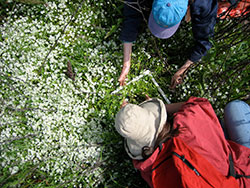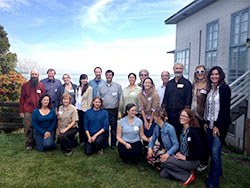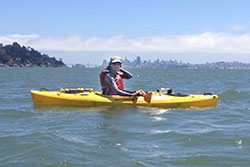
Christina conducting a population survey of the endangered Sebastopol meadowfoam

Christina with participating scientists and stakeholders after a tidal marsh management workshop in San Francisco Bay

Christina kayaking on SF Bay to survey rare American Oystercatcher populations
Dr. Christina Sloop has been CDFW’s Science Advisor since May 2018. She leads the CDFW Science Institute, where she manages programs on science support, and works with her staff to integrate climate change resilience and biodiversity conservation practices into CDFW’s scientific, management and conservation work.
A native of Munich, Germany, Christina first came to the United States as a high school exchange student. She later returned for college, earning a Bachelor’s degree in Biology with a minor in Environmental Studies from Sonoma State University, a Master’s degree in Conservation Biology from San Francisco State University, and a doctorate in Ecology and Conservation Genetics from UC Davis.
Prior to starting her current job, Christina worked for more than two years in CDFW’s Water Branch, co-authoring the 2017 CDFW Delta Conservation Framework. Prior to that, she worked in the nonprofit and consulting world, where she was active in raising awareness for climate adaptation and climate-smart practices for resource managers. She worked on sea level rise impacts and wetland restoration efforts in the San Francisco Bay, and on conservation issues related to North American migratory birds.
What drew you to the field of biological science?
I spent my childhood exploring the woods behind my house in the suburbs of Munich. These times in the woods and Sir David Attenborough’s television shows sparked my interest in nature. I was always interested in systems and how everything works together. I learned more about our environmental crisis, and so I vowed I would do my best to contribute to conservation of our natural ecosystems.
During my career I have worked primarily within the context of plant and bird conservation. As ecologist and conservation geneticist I recognize that everything is interconnected. Without plants, there is no habitat for most wildlife. Without bees or birds, there is no pollination of many species. Without wildlife, there is no seed dispersal for many plants. Nothing in nature occurs in isolation.
And humans are part of nature! For example, participating in five annual aerial waterfowl surveys opened my eyes to the critical importance of regulated hunting activities to land conservation. While humans harvest animals each season, many wetlands are protected to provide for critical habitat to ensure that both animals and sustainable hunting can thrive. Win-win! This interdependence and interconnection fascinates me and makes me want to better understand these dynamics and interactions.
As CDFW’s Science Advisor, you oversee the Science Institute. What is that?
The Science Institute is a CDFW initiative that began in 2012. It provides dedicated scientific staff and resources to support CDFW’s scientific efforts and help link science to decision-making. This support includes tools like information access, guidelines and policies, online discussion forums, communication pathways, professional development and other ways to support and connect our communities of scientists whose work informs our statewide natural resource management and policy decisions. It also helps link CDFW scientists with cutting-edge scientific projects and partnerships throughout the state relative to climate change and biodiversity, two overarching topics that fundamentally affect our work statewide.
The Science Institute’s recent  2018-2019 Progress Report (PDF) highlights some of our accomplishments to date. There are so many ways that we can help connect the dots. The work we are doing touches every corner of the department, and ultimately, helps us provide better service to the people of California.
2018-2019 Progress Report (PDF) highlights some of our accomplishments to date. There are so many ways that we can help connect the dots. The work we are doing touches every corner of the department, and ultimately, helps us provide better service to the people of California.
What have you found to be the most challenging aspect of your job?
It is very interesting, yet a bit challenging, to pull together details of the many scientific efforts statewide. California is a big state and there is a lot of critical scientific work done, and yet to do, by CDFW staff. We are currently creating a knowledge base that supports our overarching strategic planning efforts and helps us to inform each other about how our work may link together, and how we may be able to learn from each other and find efficiencies.
Since the beginning, our goal has been to put in place pathways for us to more easily plan ahead, taking anticipatory rather than reactionary actions in order to serve our Department mission. Therefore, for the past two years, we have been working with our scientists to develop a five-year strategic action plan for the Science Institute to guide our actions from 2020-25. We incorporate information in this plan gathered from targeted interviews, planning workshops, roadshows to all CDFW regions, a Science Institute staff retreat, and our 2020 Science Symposium.
The Science Institute Strategic Action Plan is now in its final stages of completion and will be released this summer. With the Plan in hand, we can adjust which actions are priorities to accomplish each year, which to wait on, or which to prepare for in the background, depending on the opportunities or restrictions we are facing at the time. This is especially pertinent in this time of the COVID-19 pandemic, where many of our science efforts in the department have been affected. However, since we (almost!) have a Plan in place, we are more nimble in our response to this crisis, changing our course accordingly to still make progress in supporting science at CDFW.
Everyone’s best efforts to plan ahead have been put to the test in light of COVID-19. How has the pandemic changed the way CDFW does scientific work, and how has the Science Institute been able to assist in the transition?
In many cases, our scientists and engineers are continuing to perform their duties as best as possible under the mandatory social isolation guidelines. However, this brings with it challenges, especially in situations that include small vessels, where it is hard to keep an adequate distance, while having to fit more than one person for safety reasons.
In order to keep our staff as safe as possible, other CDFW scientists have been ordered to refrain from field or laboratory work and to continue other scientific tasks like data analysis and reporting by teleworking. Many scheduled field research or monitoring efforts are canceled this year, resulting in the lack of 2020 reference data to inform resource management activities – for example, long-term population studies on elk, or other sensitive species.
Another challenge this crisis has brought about is that our programs that are engaged in the captive breeding of sensitive species, such as white abalone, are finding it challenging to harvest food resources for their colonies due to limited beach access. And the uncertainty of how long the pandemic will last hampers the ability of our scientists to plan future field work or ocean studies, or schedule trips to retrieve information from established research plots. Inability to attend to these plots could mean the loss of substantial investment of time, money and critical information, especially when the research relates to listed species.
The Science Institute has been working with members of the Science Institute Advisory Team, composed of representatives from all CDFW Regions and Branches, to open communication channels to share information and experiences. The Science Institute plans to engage with science programs across the state to gather more specific information on the limitations and impacts this pandemic has brought to department scientific endeavors. Obtaining and documenting this information is critical to inform planning and the department’s readiness for future emergency situations.
What challenges do you think lie ahead for CDFW scientists?
My sense is that the uncertainty of how long this pandemic will last will prove challenging for our scientific programs, as adequate planning, which is vital for many research efforts, is practically impossible. Continued funding for our scientific work is also uncertain in many cases. A half-baked scientific study is usually not worth much, thus if funding dries up, already-invested money and effort may be lost. This will also very likely affect our overall scientific capacity, where less science staff are asked to do more. I think our scientific programs can work on reexamining their priorities and Science Institute staff can facilitate this and work with interested programs to identify ways to focus available resources specifically on those priorities.
What successes have you seen as CDFW adjusts to the changes brought about by COVID-19?
I have been really impressed at how well our community of scientists have responded to their changed working conditions, and the reality that this “new normal” means to approach work with an innovative mind, focusing on what is possible rather than dwell on what is not. My impression is that the department, has thus far proven largely resilient under these unprecedented circumstances. Way to go! This brings me hope that as the economic repercussions become more real to all of us in the coming months and years, we will be as resilient as possible to continue our important work for California’ natural resources and for all Californians.
###
CDFW Photos. Top Photo: Christina performing an aerial waterfowl survey for the annual national mid-winter survey.